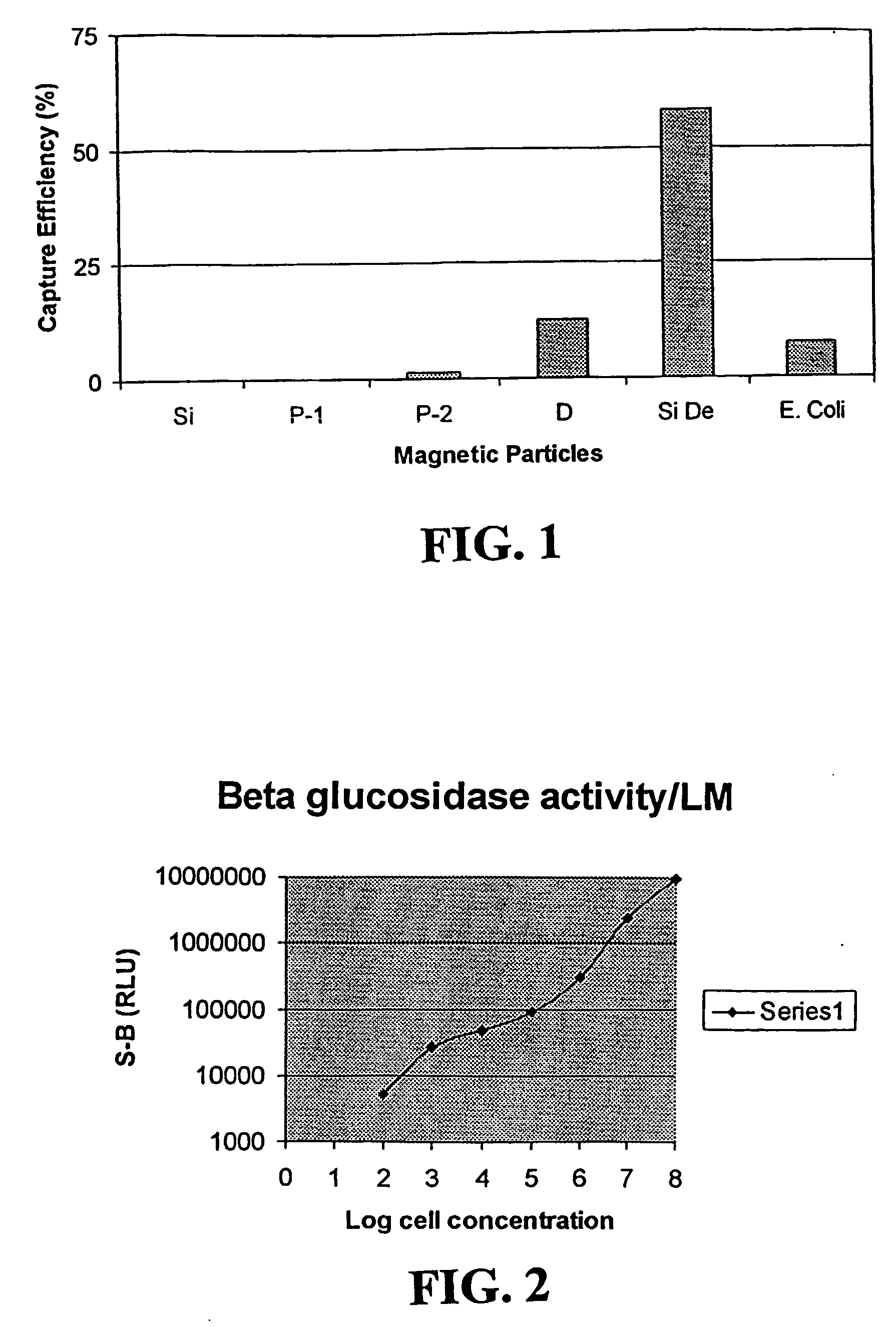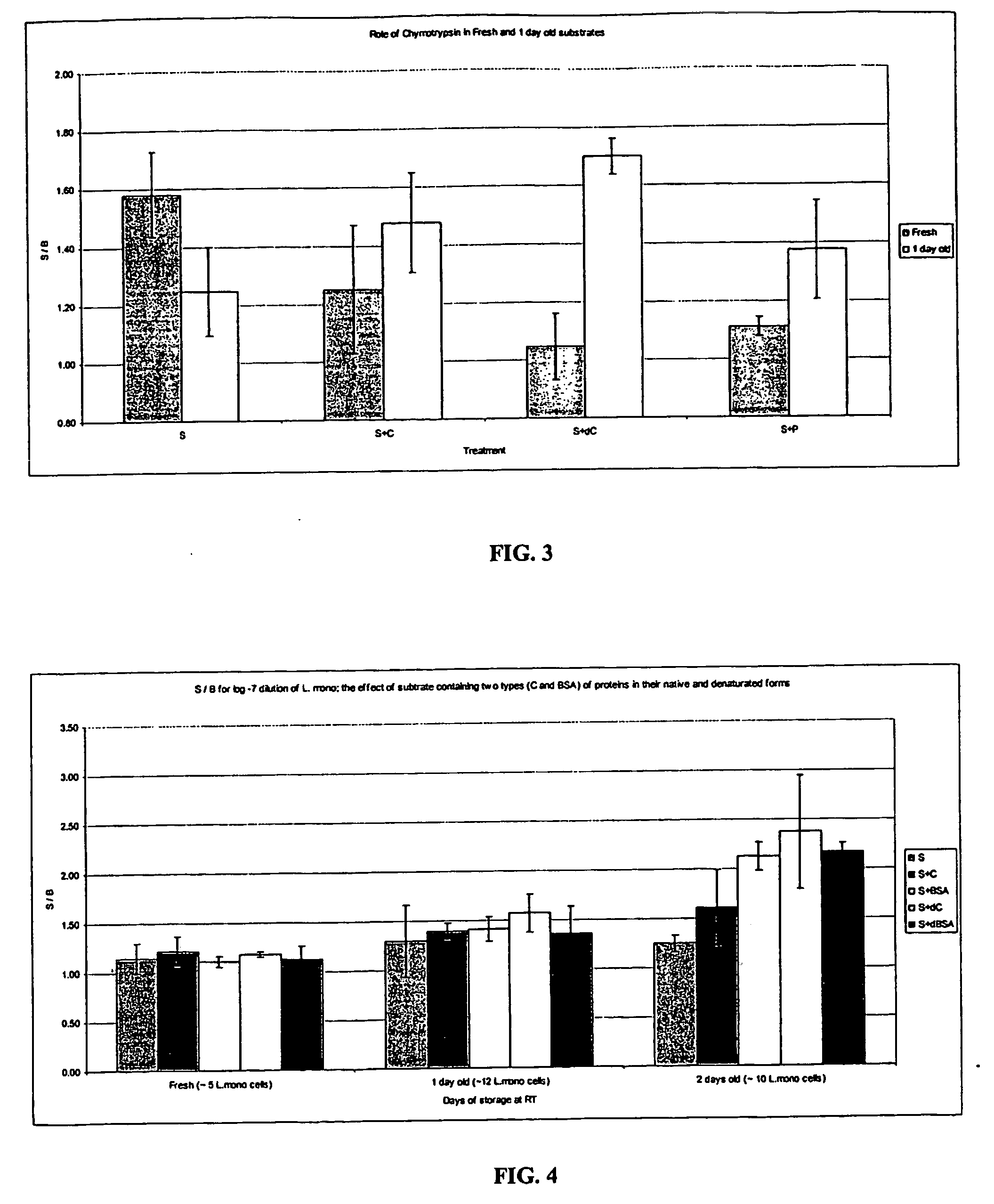Method and Kit for Detecting Listeria Spp.
- Summary
- Abstract
- Description
- Claims
- Application Information
AI Technical Summary
Benefits of technology
Problems solved by technology
Method used
Image
Examples
example 1
Capture Efficiency of Immuno-Magnetic Particles
[0038] Magnetic particles obtained from Micromod were modified as described previously and coupled with anti-Listeria IgG. Listeria monosytogenes, a laboratory isolate, was grown in trypticase soy broth at 32° C. for eighteen hours in the presence of an isolated environmental contaminant. Cells were serially diluted in 0.1% peptone water, and an aliquot was plated on PALCAM agar plates for counting. PALCAM agar is selective differential medium for the isolation of Listeria monocytogenes from food, clinical and environmental specimens. Selectivity is achieved by the combination of antibiotic supplements and microaerobic incubation. The double indicator system of aesculin hydrolysis and mannitol fermentation aids differentiation of Listeria spp. from enterococci and staphylococci which can be confused with Listeria spp. on other types of culture media. The name PALCAM derives from the various reagents added to the agar: Polymyxin, Acrifl...
example 2
Sensitivity Limit for the Listeria β-Glucosidase Enzyme
[0041]Listeria monocytogenes cells of Example 1 were serially diluted as described in Example 1. The G-8-β-glucoside, {(4-(2-phenoxyethoxy)-4-(3-phosphoryloxy-4-chlorophenyl)} spiro {1,2-dioxetane-3,13′-tricyclo{7.3.1.02,7}tridec-2,7-ene}, disodium salt, was purchased from Michigan Diagnositcs. Eight (8) milligrams of the glucoside was dissolved in 0.5 mL of dimethyl sulfoxide and further diluted into 100 mL of HEPES buffer, pH 7.0. Fifty (50) microliters of each of the cell dilutions was mixed with 0.1 mL of the substrate solution and incubated for sixty minutes at 32° C.
[0042] The samples were then removed from the incubator and 0.1 mL of a 1 mg / miL solution of the “enhancer” polymer dissolved in 1M tris-HCl buffer, pH 9.6, was added. The enhancer polymer is a co-polymer of styrene and a polymerizable quaternary ammonium monomer. The preferred enhancer is a poly(vinylbenzyl) ammonium polymer having an weight average molecula...
example 3
Listeria Analysis of Environmental Samples From a Poultry Plant
[0046] Aliquots of environmental samples (500 μL each) obtained from a local poultry processing plant were treated with 30 μL of the silica-dextran particles of Example 1 for sixty minutes at room temperature. The samples were washed twice with HEPES buffer and re-suspended in 1.0 mL of the same buffer. Fifty (50) μL of the sample was placed in a glass tube and 0.1 mL of the β-glucosidase substrate of Example 2 was added. This mixture was then incubated at 30° C. sixty minutes. The samples were brought to room temperature and 0.1 mL of the enhancer polymer added prior to reading the luminescence as described in Example 2.
[0047] Table 1 depicts the data obtained from this analysis. Comparison of the signal background ratios yielded three positive samples, and three presumptive positives (because of the small increase over background signal). These samples were found to subsequently have two confirmed positives for Liste...
PUM
| Property | Measurement | Unit |
|---|---|---|
| Time | aaaaa | aaaaa |
| Time | aaaaa | aaaaa |
| Time | aaaaa | aaaaa |
Abstract
Description
Claims
Application Information
 Login to View More
Login to View More - R&D
- Intellectual Property
- Life Sciences
- Materials
- Tech Scout
- Unparalleled Data Quality
- Higher Quality Content
- 60% Fewer Hallucinations
Browse by: Latest US Patents, China's latest patents, Technical Efficacy Thesaurus, Application Domain, Technology Topic, Popular Technical Reports.
© 2025 PatSnap. All rights reserved.Legal|Privacy policy|Modern Slavery Act Transparency Statement|Sitemap|About US| Contact US: help@patsnap.com



